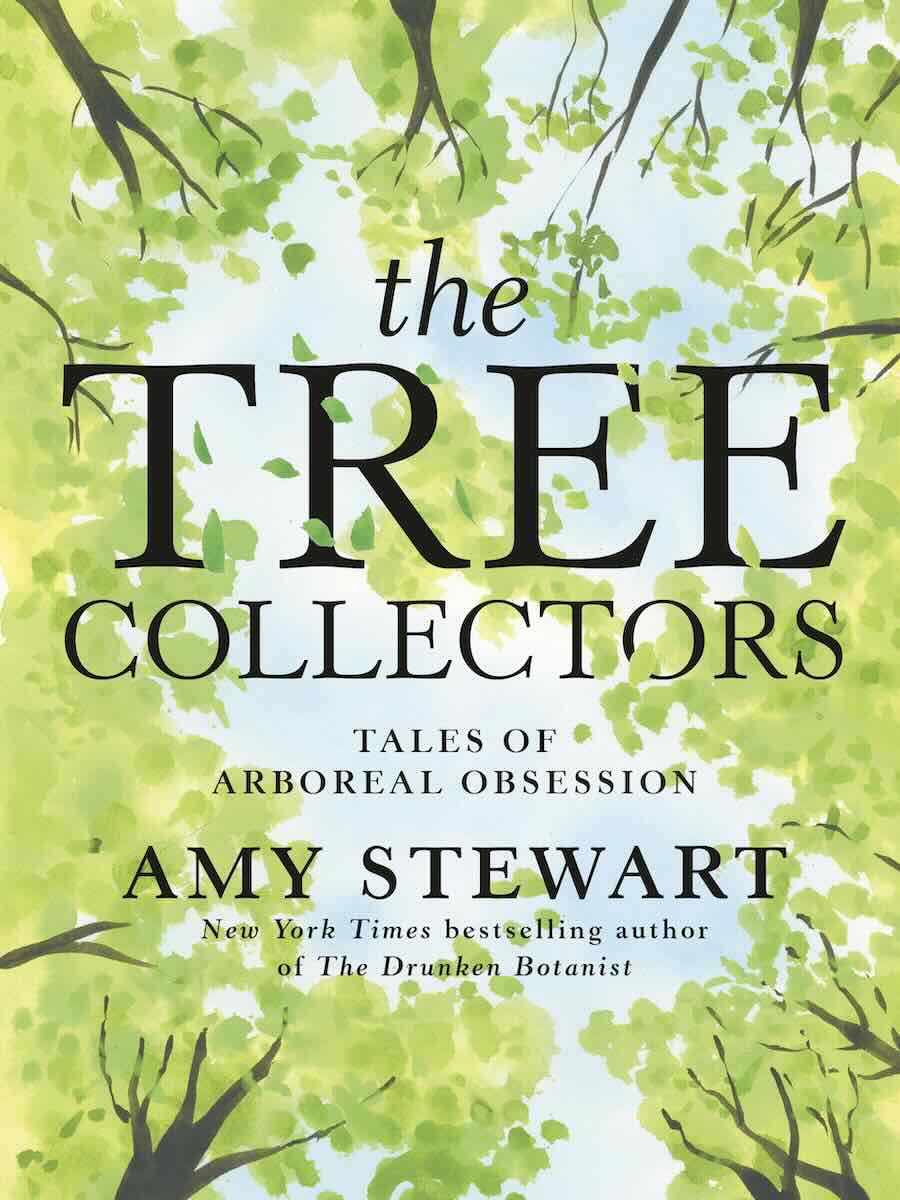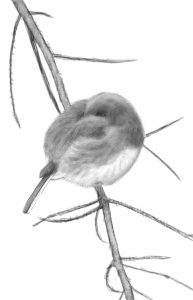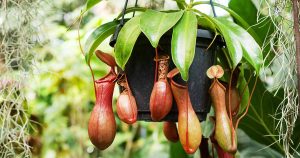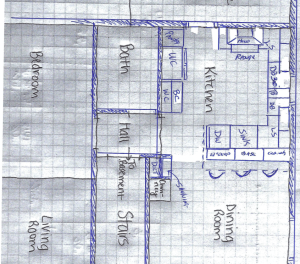
WE’RE GOING TO talk about collectibles today, but not the kind you score at a flea market or from an online auction. We’re going to talk about collectible trees. Yes, trees. A new book by Amy Stewart called “The Tree Collectors” introduces us to 50 people whose lives have been transformed by what she calls their “arboreal obsessions.”
Amy, who’s based in Portland, Ore., is a “New York Times” bestselling author whose previous nonfiction books about the natural world also include “The Drunken Botanist,” and “Wicked Plants.” Her newest, “The Tree Collectors: Tales of Arboreal Obsession” (affiliate links), is out this month, and she joined me to talk about the people and trees she met in the process of writing it.
Plus: Comment in the box near the bottom of the page to enter to win a copy of her new book.
Read along as you listen to the July 22, 2024 edition of my public-radio show and podcast using the player below. You can subscribe to all future editions on Apple Podcasts (iTunes) or Spotify (and browse my archive of podcasts here).
 ‘the tree collectors,’ with amy stewart
‘the tree collectors,’ with amy stewart
Margaret Roach: I have gardener friends out your way in Portland, and I’ve been hearing talks of a recent stretch of 100-degree days. I hope you’re O.K.
Amy Stewart: I know. Yeah, we’re not used to it in Portland.
Margaret: No, madness, madness, madness. Congratulations on the new book; you’ve been busy, I can see.
I just wanted to ask: It’s not a topic I’ve ever really thought about. I know Gesneriad collectors, and orchid collectors, and Aroid collectors, and even like heirloom-tomato collectors, but tree collectors—I don’t know any really, unless we’re talking about arboreta, or a nursery that specializes in a particular kind of trees. How did this come into your head? How did this happen?
Amy: Well, I was the same way. It had never occurred to me that people collected trees. But I was at an event of some kind about 10 years ago, and a guy came up to me and told me that he was a tree collector [laughter]. I said, “Well, O.K. Trees are really big and hard to move, so that’s a weird thing to collect. What do you mean? How does that even work?” In his case, he told me that he had a big plot of land, and he planted his trees in rows, like books on a bookshelf. His goal was just to collect as many different trees as he could that grew in his part of the world, in Lancaster County, Pa.
I thought that was very interesting, and I remember coming home and mentioning it to my husband, who’s a rare-book dealer. So there’s a lot of talk about collectors and collecting in our house, and he was fascinated with it as well. Then, over the years, occasionally someone else would tell me that they were a tree collector, and I always thought it would be an interesting idea for a book, but I couldn’t quite get my head around it. Once I’d met three or four of them, I just thought, “Oh, I have to do this.”
Margaret: Interesting. The Arnold Arboretum, they’re tree collectors [laughter], or MrMaple, the nursery in North Carolina, two brothers with all their Japanese maples, hundreds and hundreds of different varieties, they’re tree collectors, but I think of that as a different type of thing. The people in your book are mostly not that, exactly. As you say, between the space constraints, you can’t put it on a bric-a-brac shelf like your china dolls [laughter]. You can’t put it in a book like your stamp collection. It’s not exactly instant gratification either, is it?
Amy: Well, that’s true. There is this other element of time with a tree collection that other objects you might collect don’t have, which is that it grows and changes over time.
I think definitely on the high end… well actually, this is really true of all kinds of collecting. There’s a high end, and then there’s how everyday people like you and me might do something. I have a tiny little book collection, and it’s all the books that Annie Proulx wrote about gardening and homesteading before she became the Annie Proulx we know and love. It’s a collection of 10 books [laughter]. That’s my book collection. You can collect something and have it be really small.
In the case of tree collectors, there are people who obviously have big tracts of land, and they can buy fairly mature specimens of trees, which cost a lot more money. They can have a grand estate filled with whatever they collect. If you’re a tree collector, you might be into collecting oaks, or maples, or conifers, or palm trees. But there’s a lot of ways to collect on a much smaller scale, and actually, that was more interesting to me. What about the people who are tree collectors, but they just live in a regular suburban house with a normal-sized backyard, or maybe they even live in an apartment? What could collecting look like in those situations?
Margaret: There’s these 50 tree collectors that you’ve profiled. They’re from all over the world, Greenland and Poland, and Singapore, India, Brazil, Ethiopia. I could go on and on. The book’s introduction starts with the question that, of course, I want to now ask you, because you’ve met and interviewed all these tree collectors: “What possesses someone to possess a tree?” That’s how you begin the book.
Amy: Well, it’s interesting. A lot of these folks I recognized immediately as true collectors. If you’re someone who is in your heart a collector, you’ve probably collected other things over the course of your life before you got into trees. Maybe you were a stamp collector, or you collected baseball cards. You’re someone who has that kind of acquisitive nature, like, “I must have one.” And then, once you realize that there’s a bunch of them in that category, there’s this urge to be completist about it, and to say, “I need one of every one, and I won’t be satisfied until I fill in the holes, and I have the complete set.”
I understand that mindset, and definitely, there are tree collectors who are like that. There’s a woman in the book who collects pine cones, and she decided that she would collect one of every species of pine in the world, and she hasn’t been able to finish it. It’s hard to do, but there’s something about the quest, and having that list in your head of, these are the ones I’m really after, that’s sort of delightful. I think that’s part of what drives tree collectors, but there are definitely people who are planting trees for more, I would say deeply personal reasons, and really heartfelt reasons.
Margaret: Yeah, and I want to talk about some of those that struck me. You divided the book in categories, sections according to what you saw as each person’s primary motivation for collecting. There’s artists, and curators, and educators, and healers, and ecologists and so forth. In the healer chapter, one thing is, as I think you point out in the book, speaking of healing and trees, forest bathing is a thing. It’s not just a thing right now. It’s a real thing. Connecting with trees is powerful, isn’t it?
Amy: It is, yeah, absolutely. I walk through the forest every day here in Portland, for a few minutes. It’s, of course, an incredibly relaxing and soothing place to be. It makes us feel better. I think it also reminds us of, again, there’s this quality of time with trees. Every morning I walk past this enormous Douglas fir, and I don’t know how old it is, but I do know that it was here many generations before I was born, and that it’ll be here long after I’m gone. There’s something about that timelessness that reminds me that my troubles and my worries are really transitory [laughter].
Margaret: Yes.
Amy: It’s that same sense of awe that you get when you look up at the stars, and you remember in a very pleasant, reassuring way that you’re kind of insignificant in the grander scheme of things.

Amy: I was so moved by this. She’s somebody who started collecting Japanese maples. She just started with one, that’s always how it starts [laughter], and then you’re like, “I didn’t realize there’s other kinds. Now I want two or three more.” She went down that road, and was able to get enough land that she could really start growing out maples at scale. The interesting thing about maple trees is that they don’t grow true from seed. If you have a Japanese maple and it drops a seed on the ground, and a new little tree sprouts from that, it’s going to look very different from its parents. You have the opportunity to possibly discover, and even introduce to the world a new variety of Japanese maple that no one’s ever seen before.
One of the things she told me is that she and her husband weren’t able to have kids, and she always felt this sense of loss that she never had a child. She said that the maple trees helped her kind of fill that hole in her life, but then she also said, about looking for a new variety that maybe comes out of her collection, that she would like to be able to introduce and name a new variety of maple tree. She said, “I haven’t been able to give a name to a child. I would like to give a name to a tree.”
Margaret: So it helped her with her grief, and gave her a forward-looking project, the next generation project?
Amy: It did, and I’m glad you said that, because that’s another really profound thing that she said. She said that all the other things that she used to collect were basically keeping her tied to the past, but that when you collect trees, you’re thinking about the future.
Margaret: Yeah, it’s a good one. In the ecologists section, I love the tale of (and I might butcher this name) Miyawaki forest plantings, the tiny forests that you say a space the size of several parking spaces, or ideally, a tennis court in size, can be a whole forest, and that there’s a man in India who, I think he consults with people in different places around the world, and makes these tiny forests. That was just incredibly beautiful as a thought.

Margaret: That’s a perky thought, huh, that cycle?
Amy: It is a perky thought. He realized what a wasteful process that was, and that eventually, someday, we will run out of natural products to put into landfills. We’ll be out. That’s the only direction it can go. So one day, this guy came to speak at his plant about building tiny forests, and this idea comes from Miyawaki, in Japan, and his idea was that you can use his particular method of intensive cultivation to plant a very dense forest that will grow very, very quickly, and fill even a really small space. This is not reforestation, this is what he calls afforestation, meaning to put a forest in a place that it wasn’t before, with the idea being that we can attract habitat, we can clean the air, help purify water. There’s a million reasons to do this.
But the way it works, and what Shubendu Sharma has done as an engineer is to systematize it. He’s now made that his life. He no longer works at Toyota, and what he does are these tiny forests. It involves very deep cultivation of the soil, abnormally deep cultivation, maybe several feet deep, so you’re probably using a backhoe for this. And then, a lot of organic material to add porosity to the soil, because basically, you’re wanting extremely accelerated root growth. You add a lot of beneficial microorganisms to the soil, and then, you plant in all four or five layers of a forest all at once, very closely together, so the understory plants, the small shrubs, the slightly taller trees that live under the canopy and the trees that will ultimately get so tall that they’ll become the canopy of the forest, and probably crowd out a lot of what was once growing underneath it.
Margaret: Wow.
Amy: The idea with this is that you have to weed it and water it for the first few years, but then, you should be able to walk away, and let it do what it’s going to do. Of course, you want to use native species that are well suited to the area, but people do this in their backyards [laughter]. I talked to Shubendu Sharma via Zoom, and he walked out into his backyard with his laptop, and showed me his tiny forest.
It is impenetrable. It’s not meant to be a recreational space for humans. It is meant to be a forest that’s not for us, but that is for wildlife. These go into vacant lots and city parks, and corporate campuses and people’s backyards all over the world.
Margaret: It reminded me of this idea called pocket forests that Basil Camu, the co-founder of this tree-care company, actually, in Raleigh, N.C., Leaf & Limb. He promotes this pocket forest idea, and he has a nonprofit within it that grows a lot of saplings of native trees, and distributes them for free to different conservation projects and community projects around the area, and teaches people to plant, like you’re saying, very intensively, very close together, and make these pocket forests. It’s just wonderful. It’s transformational both for the people and for the space, to get involved with these baby trees.
Amy: Sure.
Margaret: Another one in the ecologists section was from Greenland, and silly me, I didn’t really know that trees don’t really historically grow there. It’s not a place of forests, it’s not a country of forests, and that’s changing along with the climate, I guess. The collector you profiled is exploring maybe which trees may have a chance in the Greenland of the future. Is that a good rough summary of what he’s doing? Tell us about him.
Amy: Yeah, exactly. Well, you and me both, it didn’t occur to me that there weren’t trees in Greenland. Part of it is that it’s above the tree line, there’s an Arctic tree line above which trees don’t grow, but also, because even in southern Greenland, where there could be trees and maybe once were trees, there’s now cattle grazing, and sheep. Trees don’t stand a chance. This is what you might see in a place like the British Isles. You see these kind of treeless spaces that are given over to sheep farming and stuff like that.
Part of it’s that, but there really was never just much interest in trying to figure out if trees would grow. Of course, with a warming climate, a lot of tree species are moving in that direction, and even birds are helping to transport tree seeds.
Margaret: They’re good tree planters.

They’re looking for trees all around the world that grow close to that Arctic tree line, like Siberian larch , things like that, to just see what can even make it here. And then, the next generation will decide, do we want this for timber production? Do we want it for recreational uses, nice scenery, planting trees in people’s backyards? Imagine living in a place where you never see a tree. It would just be nice to see some trees. Any number of reasons why it might continue, but it will be the work of the next generation to figure all that out.
Margaret: He’s trying to help develop a palette that at least could be considered for fill-in-the-blank purpose? [Above, Kenneth Hoegh.]
Amy: Exactly.
Margaret: He’s doing the test, the R&D testing.
Amy: The R&D, right.

Amy: Sam Van Aken [below], yeah.
Margaret: With his Tree of 40 Fruit. He had this quote, it said, “‘I thought grafting was the perfect metaphor for contemporary existence,” he told you. He said, “In so many ways, I feel like our lives are all so piecemeal and hybridized and patched together.” So he is grafting 40 fruits onto one kind of tree?
Amy: Right. If you think about it, yeah, if fruit trees are your thing, you only need one tree to have a tree collection [laughter]. The interesting thing about that, he is an artist, and he does these as art projects. There are also drawings that accompany it. It’s a whole thing. It’s a whole project that he does. The thing about grafting many different kinds of fruit onto one tree—now these are all stone fruit, so it would be plums and cherries and stuff like that—is that you don’t go out just on one day and graft 40 different fruits onto a tree.
Margaret: No.
Amy: It’s something that you have to do over time. First of all, the tree has to be in exactly the right season, and the right stage of its growth for the graft to take hold. Another thing is that not every graft is going to take well to its host tree. It has to use these interstock. There’s certain fruit trees that are good bridges between two others.
Margaret: Yes.
Amy: Sometimes he’ll have to go and graft on that interstock and then wait a year or two, and then graft on the fruit tree he wanted that can now be accepted into the host tree, because there’s a little bridge there that works for it. This is a process that actually takes many years for one tree. And here again, these are trees that you can find, some of them are on the grounds of museums or universities, something like a zoo, or a science museum, or something like that might have one of his trees. He has actually done a whole bunch of them on Roosevelt Island in New York City.
Margaret: Oh?
Amy: Yeah. The cool thing about it, first of all, they’re beautiful, because I want you to try to imagine—we all love the way cherry blossoms look in the spring, but imagine a tree that has many slightly different colors of blossoms, and the bloom cycle is happening over a longer period of time, because it’s a bunch of different types of-
Margaret: Wow.
Amy: Exactly. Also, the fruit you get can come over a long season. You could start picking fruit in June and still be getting fruit in September. It’s not like, “My tree is fruiting, and I’m dumping bags of plums on everybody’s front door step, because they all have to be harvested in the same week.” You’re getting a few handfuls of fruit per week all summer long, which is what most of us can handle in our household.
Margaret: It seems like in the stories, these profiles of the 50 people, that each one experienced a kind of change, a personal transformation from this relationship with this tree collecting. Maybe just say a little bit about that, and also about what you hope the reader gets out of “meeting them,” and by reading the book, because I think that’s important, too, and potentially transformational.
Amy: I think the only way I can really sum it up is to say that a life with trees is a life well-lived [laughter]. I was struck over and over again by how many of these people had built stronger communities and stronger relationships with their friends and families through the trees. It happens in so many different ways across this book that I couldn’t even begin to summarize it, but I was just struck over and over again at what rich lives people have, not just with their trees, but with the people in their lives because of the trees. That was just extraordinary for me.
Margaret: Like we talked earlier about, one woman who it helped with her grief, that was certainly transformational compared to grieving all the time about not being able to have the children and so forth. It seems like there are enormous potential changes from being so intimately involved with these living, long-lived things, these trees. Any trees being collected over there in your garden? [Laughter.]
Amy: Well, I live in an apartment, so there’s no trees being collected in my house. I will tell you, there’s an oak tree down the street that I really love, and I missed my chance this year, but I do intend to go collect some acorns and just sprout them on my balcony and see what happens, because it’s just a tree I’m particularly fond of. Any of us can do that.
Margaret: Yeah, they’re so beautiful. Even squirrels can do that. They’re so beautiful. Acorns are so incredibly intricate, and beautiful.
Amy: They are.
Margaret: I should have said at the beginning that you didn’t only write the book, you also illustrated it. I don’t know how you figured that out, but you illustrated it, so congratulations on that as well. And again, congratulations. Again, I thought, “Tree collectors, what, huh?” The portraits of the people, they’re very compelling, and each one is distinct. It’s not the same story in each case, and it’s fascinating. Thank you. Thanks a lot.
Amy: Well, thank you. Thanks for having me.
enter to win a copy of ‘the tree collectors’
I’LL BUY A COPY of “The Tree Collectors,” by Amy Stewart, for one lucky reader. All you have to do to enter is answer this question in the comments box below:
Do you collect any kind of plant at all, tree or otherwise, or is there maybe a plant collection you like to visit? Tell us (and say where you garden).
No answer, or feeling shy? Just say something like “count me in” and I will, but a reply is even better. I’ll pick a random winner after entries close at midnight Tuesday, July 30, 2024. Good luck to all.
(Disclosure: As an Amazon Associate I earn from qualifying purchases.)
prefer the podcast version of the show?
MY WEEKLY public-radio show, rated a “top-5 garden podcast” by “The Guardian” newspaper in the UK, began its 15th year in March 2024. It’s produced at Robin Hood Radio, the smallest NPR station in the nation. Listen locally in the Hudson Valley (NY)-Berkshires (MA)-Litchfield Hills (CT) Mondays at 8:30 AM Eastern, rerun at 8:30 Saturdays. Or play the July 22, 2024 show using the player near the top of this transcript. You can subscribe to all future editions on iTunes/Apple Podcasts or Spotify (and browse my archive of podcasts here).
 ‘the tree collectors,’ with amy stewart
‘the tree collectors,’ with amy stewart







